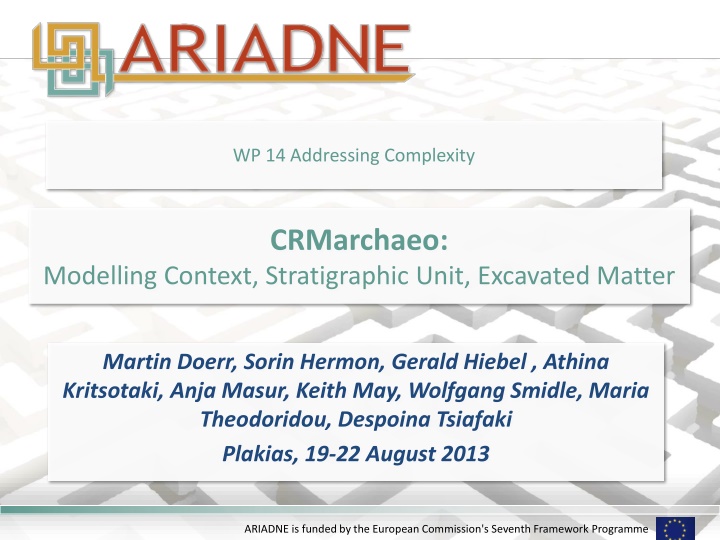
Archaeological Complexity through Modeling and Excavation Processes
Explore the intricacies of archaeological research presented at a 2013 conference, focusing on modeling, excavation processes, stratigraphic units, and scientific observations. Delve into the detailed methodologies, techniques, and intentional actions involved in excavating and analyzing historical sites to uncover valuable insights into past civilizations.
Download Presentation

Please find below an Image/Link to download the presentation.
The content on the website is provided AS IS for your information and personal use only. It may not be sold, licensed, or shared on other websites without obtaining consent from the author. If you encounter any issues during the download, it is possible that the publisher has removed the file from their server.
You are allowed to download the files provided on this website for personal or commercial use, subject to the condition that they are used lawfully. All files are the property of their respective owners.
The content on the website is provided AS IS for your information and personal use only. It may not be sold, licensed, or shared on other websites without obtaining consent from the author.
E N D
Presentation Transcript
WP 14 Addressing Complexity CRMarchaeo: Modelling Context, Stratigraphic Unit, Excavated Matter Martin Doerr, Sorin Hermon, Gerald Hiebel , Athina Kritsotaki, Anja Masur, Keith May, Wolfgang Smidle, Maria Theodoridou, Despoina Tsiafaki Plakias, 19-22 August 2013 ARIADNE is funded by the European Commission's Seventh Framework Programme
CRMsci: a Scientific Observation Model E7 Activity P2 has type E55 Type E13 Attribute Assignment S5 Inference Making O11 observedProperty S9 Property Type S4 Observation O10 observed Inspired by INSPIRE, OBOE S8 Categorical Hypothesis Building S6 Data Evaluation P40 observed dimension E16 Measurement E54 Dimension S7 Simulation-Prediction O14 assigned dimension P39 measured O16 described O17 has dimension S1 Matter Removal S19 Observable Entity O1 diminished E70 Thing S2 Sample Taking E5 Event S10 Material Substantial O3 sampled from O2 removed O5 removed S11 Amount of Matter E18 Physical Thing S14 Fluid Body S13 Sample
CRMarchaeo: Excavation Process Unit Substance: doing Identity: Actor, location, temporal coherence Unity: begin/end (maybe documented) Intentional, Declarative P67 refers to E29 Design or Procedure E55 Type technique SP6 Declarative Place E7 Activity P32 used general technique P33 used specific technique planned area E55 Type Q11 approximates for drawings before excavating about where to excavate methodology SP2 Phenomenal Place P32 used general technique AP3 excavated 3D excavated area E55 Type P125 used object of type A1 Excavation Process Unit P13 destroyed tools AP6 occupied P21 had general purpose constellation of Matter that happened to be at the excavated place A9 Constellation of Matter E55 Type find Solomon s Temple S10 Material Substantial AP5 cut P17 was motivated by A2 Stratigraphic Unit AP1 produced AP2 discarded into AP4 produced surface E73 Information Object preserved part or total of matter research question E26 Physical Feature S11 Amount of Matter S11 Amount of Matter surface a basket a heap
CRMarchaeo: Stratigraphic Genesis A process resulting in the displacement of a limited amount of matter which has settled into a relatively stable form, often a deposition, consisting of homogeneous parts. E63 Beginning of Existence E7 Activity A1 Excavation Process Unit A4 Stratigraphic Genesis AP9 took matter from AP7 produced SU AP8 produced SI AP1 produced S10 Material Substantial E26 Physical Feature S11 Amount of Matter A3 Stratigraphic Interface A2 Stratigraphic Unit
CRMarchaeo: Discovery Event (draft) A1 Excavation Process Unit E5 Event P9 consists of E3 Condition State? positioning A8 Discovery Event AP14 has found embedding state, refinement of position A7 Embedding AP15 has found object AP13 embedding in AP11 embedding of AP12 embedding at E19 Physical Object E53 Place Context Stuff the Physical Object has a position at least up to the point of discovery reference space that is relative to the Context Stuff
